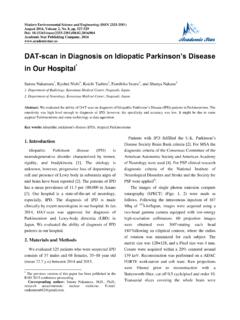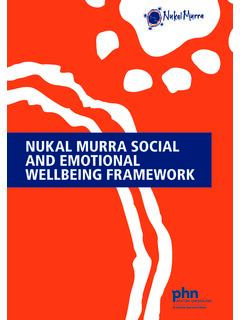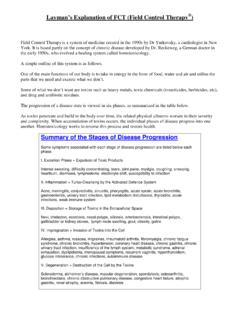Transcription of Breakthrough Pain and Pain Management - - RN.org®
1 Breakthrough pain and pain Management Reviewed September, 2016, Expires September, 2018 Provider Information and Specifics available on our Website Unauthorized Distribution Prohibited These articles were selected by the Dannemiller Foundation, abstracted and reviewed by a pain physician for thoroughness and accuracy. Used with written permission from Dannemiller Foundation for educational purposes and is not responsible for the contents. Objectives Discuss alternative treatments of Breakthrough pain in cancer pain patients receiving spinal analgesics. Review the use of oral transmucosal fentanyl citrate for the treatment of Breakthrough pain in patients with cancer.
2 Determine the incidence and possible treatment modalities of Breakthrough pain in opioid-treated patients with non-malignant pain . Report on a placebo-controlled study of fentanyl buccal tablet for Breakthrough pain in opioid-treated patients with cancer. Review the pharmacological and clinical characteristics of oral transmucosal fentanyl citrate for the treatment of Breakthrough pain in patients with cancer. Discuss reasons buprenorphine has failed to gain popularity in the treatment of cancer-related pain . Review the prevalence, characteristics, and treatments of Breakthrough pain in patients receiving opioid therapy for chronic noncancer pain .
3 Assess the efficacy and safety of a radioisotope to reduce incident pain in patients with bone metastases following prostate cancer. Report the use of a computer-integrated infusion system to provide patient-controlled continuous epidural analgesia during labor. State the advantage of precision diffusion kinetics in the administration of potent opioid analgesics. Alternative treatments of Breakthrough pain in patients receiving spinal analgesics for cancer pain . Mercadante S et al Journal: J pain Symptom Manage, 30(5):485-491, 2005. 18 References Reprint: Anesthesia & Intensive Care Unit, pain Relief & Palliative Care Unit, La Maddalena Cancer Center, Via S.
4 Lorenzo 312, 90146 Palermo, Italy (S Mercadante, MD) Faculty Disclosure: Abstracted by J. Joyce, who has nothing to disclose. Oral analgesics for cancer pain Management have been demonstrated as successful in the majority of patients. Nevertheless, some patients fail to respond to pharmacological therapy or suffer from unacceptable adverse effects. As a result, more complex and individualized treatments requiring multiple analgesic regimens and alternate administration routes are required to effectively address the shortcomings thus far experienced. For patients who do not effectively respond to systemic opioid administration, including drug and/or route switching, spinal treatment may be indicated.
5 This treatment is complex and requires expertise to accomplish. Breakthrough pain is defined as a transitory increase in pain intensity on a baseline pain of moderate intensity in patients receiving regularly administrated analgesic treatment. These fluctuations are challenging to treat successfully because of the unpredictability and need for rapid intervention. Traditional treatment is based on the use of short-onset opioids administered via fast routes such as oral, transmucosal, or intravenous. The strategies of treatment are based on individual solutions. This study investigated intrathecal analgesics for cancer pain Management . The authors prospectively treated 84 episodes of Breakthrough pain in 12 patients admitted to a pain center.
6 The patients were selected for intrathecal treatment after receiving different trials with systemic opioids. They presented with Breakthrough pain that required alternative methods, including sublingual ketamine or intrathecal boluses of local anesthetics. Patients receiving spinal treatment pose important clinical problems. Regardless of the difficulties in finding the best treatment balance between local anesthetic and morphine doses, another problem is presented by the treatment of pain flares. A drug delivery system for on-demand delivery of intrathecal morphine has been developed. Intrathecal morphine has a slow onset, while local anesthetics have the shortest onset time.
7 Local anesthetics also have an individualized dose-effect relationship with narrow therapeutic windows, whether administered chronically or as a bolus. Levo-bupivacaine (LB) seems to have convenient properties and is nearly equipotent to bupivacaine. Proper dose titration under an initial strict surveillance may find the dose effective to control pain in a short period of time without producing significant adverse effects. Intranasal administration of ketamine or opioids can produce significant Breakthrough pain relief within 10 minutes, but the development of tolerance to ketamine over time cannot be excluded. Mean volumes of mL of a local anesthetic were effective within minutes and well tolerated in patients receiving a continuous intrathecal infusion of a combination of morphine and LB in different doses.
8 Similarly, ketamine in doses of 25 mg sublingually was effective and relatively well tolerated. Although the availability of transmucosal drugs remains variable, significant effects are demonstrable using mucosal absorption methods. Using drugs other than opioids, the problem of highly tolerant patients, who are poorly responsive to systemic opioids, can often be overcome. Oral transmucosal fentanyl citrate for cancer Breakthrough pain : a review. Gordon DB Journal: Oncol Nurse Forum 33(2):257-264, 2006. 60 References Reprint: University of Wisconsin Hospital and Clinics, Madison, Wisconsin (DB Gordon, RN, MS FAAN) Faculty Disclosure: Abstracted by T.
9 Tilton, who has nothing to disclose Breakthrough pain (BP) is defined as a transitory exacerbation of pain that occurs in a background of otherwise stable pain in patients receiving chronic opioid therapy. BP is generally of rapid and paroxysmal onset with a brief duration (peak intensity 3-52 min). The prevalence is reported at 51-86% in patients with cancer. Subtypes of BP include: incident, predictable (consistent temporal causal relationship with predictable motor activity, such as movement, defecation, micturition, breathing, or coughing); incident, unpredictable (inconsistent temporal causal relationship with motor activity, such as sneezing, bladder spasm, or coughing); idiopathic (not associated with a known cause; generally of longer duration that incident pain ); and end of dose (occurring before a scheduled dose of an around-the-clock analgesic, more gradual onset, and longer duration than incident or idiopathic).
10 BP is associated with increased pain -related functional impairment, psychological distress and use of medical resources. Oral morphine has not been adequate to treat BP due to its relatively low potency for an opiate as 90% is ionized at the mouth pH, and it is the least lipid-soluble opioid. Relative potency of oral transmucosal fentanyl citrate (OTFC) to morphine (IV) is about 10:1; 20 g of IV fentanyl (FEN) is approximately equivalent to 200 g of OTFC and 2-4 mg of IV morphine, or 6-12 mg of oral morphine. FDA approval is only for BP in patients with malignancies who are receiving and are tolerant to opioid therapy because life-threatening hypoventilation can occur at any dose in patients not tolerant to opioids.
















